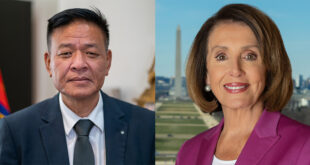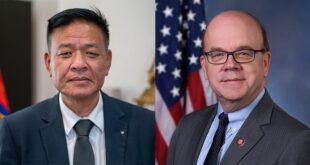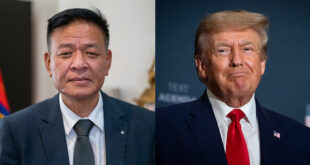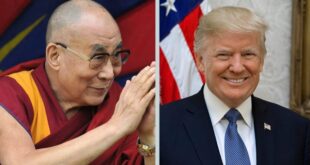Maryland, USA 7 May 2013
Just before landing at Dulles Airport at the end of His Holiness the Dalai Lama’s long flight from India yesterday, the pilot warned of heavy cloud cover over the Washington area. Today, the steady rain that fell as His Holiness drove to the Comcast Center of the University of Maryland to give the annual Anwar Sadat Lecture for Peace deterred none of the audience of 15,000 from attending. They gave him a rousing welcome when he walked onto the stage escorted by University of Maryland President, Wallace Loh, Dr Elahe Omidyar Mir-Djalali, founder of the Roshan Cultural Heritage Institute and Dr Jehan Sadat, widow of the late Egyptian President and founder of the Anwar Sadat Lecture for Peace in his memory.
President Loh welcomed everyone; Prof Shibley Telhami spoke and introduced Dr Mir-Djalali and her work to foster Persian studies. She in turn introduced Dr Jehan Sadat, touching on her work for peace and the advancement of women. Dr Sadat recalled that her husband, like His Holiness, had been awarded the Nobel Peace Prize, but noted that despite his efforts and sacrifices, peace in the region remains elusive. He knew that there had to be a comprehensive peace and that the crux of it was the conflict between the Israelis and Palestinians. In the face of this, he sought a just and lasting peace.
Introducing His Holiness, President Loh said he was honoured to host someone who calls himself a simple Buddhist monk, who has said: “My religion is simple with no need for grand temples or complicated philosophy; our heart is the temple and the philosophy is kindness and compassion.”
“When I give a talk there is no need for formality, because we are all human beings,” His Holiness began, “We are born and we die without formality. So I prefer to begin by greeting you as my respected elder brothers and sisters and my younger brothers and sisters. As human beings we are all the same; we each want to lead a happy, peaceful life and avoid problems. And each of us has a right to do so.
“We may have slightly different shaped noses and different coloured hair, but on a deeper level we are all the same; we are moved by positive and destructive emotions. We have the same potential. “
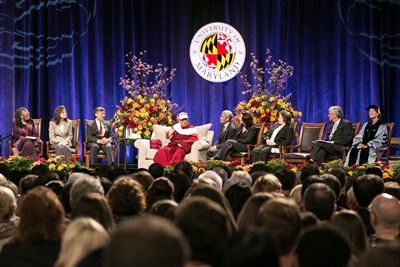
He repeated that we all want a happy life, but asked what long lasting happiness consists of. He pointed out that the sensory pleasure we are used to is short lived, but that lasting inner peace comes from mental training. In that context, hermits, who spend most of their lives in meditation, tap into a source of deep and lasting happiness. His Holiness recalled meeting a Spanish monk who had spent five years in retreat meditating on love. When he talked to him there was a brightness in his eyes that revealed his peace of mind, which was not the result of sensory experience but of inner tranquillity.
“Material development is essential for our physical comfort, but we also need inner values. Inner peace is essential for our well-being and even our good health. I sometimes half tease young women about the time and money they spend on cosmetics. Of course, external beauty has its place, but far more important is inner beauty.” This stirred the audience’s laughter and applause.
“A more compassionate attitude gives us self-confidence. With that we can be more transparent and honest – this creates trust. Trust is the basis of friendship and we need to remember that we are social animals who need friends.”
His Holiness continued:
“I am very honoured to have been invited to give this Anwar Sadat Lecture for Peace. President Sadat took bold steps to create peace in the Middle East. Today, I am happy and honoured to have met his widow and to have been able to tell her what an admirer I was from a distance of the actions he took to overcome mistrust and suspicion.”
Reflecting on the role of religion, he asked why the different religious traditions offer different philosophical views and practices, answering that it is to create a better more compassionate person. He said that peace in the world must come from inner peace within individuals and the source of that inner peace is compassion for others. People have different attitudes and approaches; they have different ways of life. But when we realise the common aim of our various religious traditions, we can develop mutual respect, and on that basis we can learn from one another.
He remarked that the twentieth century was a period of bloodshed and violence, which is why he hopes the twenty-first century will be instead a century of peace and dialogue. The generation who are young today have an opportunity to create a better world on the basis of the oneness of humanity. Continuing to dwell on the secondary differences between us, while overlooking the oneness of humanity and humanity’s needs will lead to disaster.
As a final challenge His Holiness proposed, to loud applause, that we aim to achieve a demilitarised world; something, he asserted, that really is possible.
Asked about ethics in education, he said that education is what shapes the world.
“We need to educate people to understand that their own well-being depends on others, whereas problems derive from a lack of inner values. We are investigating how to introduce ethics into modern education, something that involves the mind. We need to develop a map of the mind and an appreciation of the value of affection. Children readily recognise and respond to affection, but adults try to fool themselves that they can do without it. What we need is secular ethics.”
With regard to trying to achieve inter-religious harmony, His Holiness acknowledged that there is conflict among Buddhists as well as other traditions. In connection with the recent cases in which Buddhists have been harassing Muslims in Burma, he said he had appealed to the Buddhists there to remember the face of the Buddha and to reflect that if the Buddha were among us today, he would offer those Muslims his protection.
As the meeting neared its conclusion, President Loh awarded His Holiness an Honorary Degree of Doctor of Humane Letters presenting him with the hood and citation. In addition he made a gift to His Holiness of a work of Art for Peace, an award winning piece of sculpture symbolising dignity. In his expression of gratitude, His Holiness said that such gestures of acknowledgement encourage him in his efforts to contribute to the betterment of humanity. Turning back to the audience, he asked them to consider what he had said, to assess whether it had any value, if it did to familiarise themselves with it and to try to put it into practice in their daily lives.
Meeting a local inter-religious group during the lunch break, he said:
“We must aim to end conflict in the name of religion. Your group is small, but it is like a seed. Without a seed there is no growth, but from one seed great things grow. Your work is wonderful and is one of the best ways to fulfil the wishes of the founders of your respective faiths.”
Addressing guests attending a luncheon reception at the President’s House, he said:
“As human beings we are intelligent, but we also need warm-heartedness. Please bring warm-heartedness to bear in your work in the education system. Among human beings trust comes about, not from expressions of wealth or fame, but from our showing affection. Then you can speak and act with honesty and transparency, which serves to reinforce trust and friendship.”
In the afternoon, at the Clarice Smith Performing Arts Center, His Holiness participated in a Meeting of Two Oceans: Dialogue on Sufism and Buddhism. After President Loh’s welcoming words, the Dean, Bonnie Thornton Dill set the scene for the meeting and thanked all who had made it possible, singling out Ven. Tenzin Dhonden for appreciation. Elahe Omidyar Mir-Djalali, founder of the Roshan Institute, spoke of her friendship with His Holiness and how in recognition of the oneness of humanity he has promoted a sense of universal responsibility. She said:
“He reminds me of the high ideals of Sufism that I absorbed in my childhood and the saying ‘You are what your heart is’. Sufism is the awakening of the voice of inner knowledge encompassing the ethical precepts common to all world religions.”
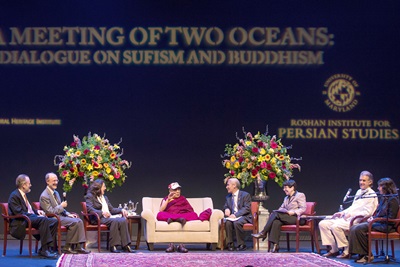
She introduced Fateme Keshavarz who read from the poet Rumi and was accompanied by Hossein Omoumi, player of the ney, the traditional reed flute of Iran and Jessika Kenney, who sang. She quoted Sufi tradition that the inner voice, the qualities of the heart, can be awakened by music. Ahmet Karamustafa spoke about the Sufi journey from ordinary selfishness to selflessness and how Sufis would organise themselves around a Sufi master, while Carl Ernst talked about the Sufi role in the harmony between Hindus and Muslims in India.
His Holiness mentioned his acquaintance with a Sufi master living in Paris, whose son came to India to study Buddhism. He acknowledged that Dr Mir-Djalali had told him about the resonance between Sufism and Buddhism, noting that when she said that Sufi means knowledge and cognition, he reflected that this corresponds with Sanskrit Buddhism’s emphasis on analysis and wisdom.
He appreciated the music and singing, which he said we find in all religious traditions, but cautioned that if we become too attached to the instrument or the technique we risk forgetting the meaning, so the point is lost. A Tibetan master said this was like clinging to the branches while ignoring the roots, to which Fateme Keshavarz quickly responded that for Sufis music is a way to reach the roots. She said she grew up thinking that God was part of us, not something somewhere else. His Holiness agreed, saying that Buddhists refer to Buddha nature, which might be thought of as our deeper nature. Our job is to awaken it.
His Holiness also appreciated a similarity of metaphors in the veils of ignorance that need to be peeled away; 70,000 according to Sufi tradition. Buddhists refer to 84,000 veils of destructive emotions.
In his concluding words His Holiness said it was very good to have such opportunities to appreciate the similarities in our traditions. He stressed that the time has come to really work to promote religious harmony and that to do that effectively we must develop mutual respect and understanding. This should involve exchanges of experience not just works of scholarship. He said:
“I appreciate all of your efforts to organise this gathering and look forward to when we can do it again.”

